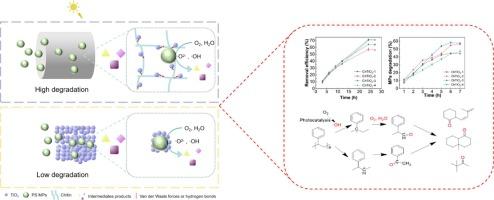二氧化钛分散于几丁质基质中以提高光催化性能降解聚苯乙烯微塑料
IF 6.9
2区 材料科学
Q2 CHEMISTRY, PHYSICAL
引用次数: 0
摘要
微塑料(MPs)已被调查证明对健康构成重大风险,因此有必要深入探索消除技术。本研究采用冻融法将TiO2纳米颗粒分散并固定在甲壳素海绵基质上,制备了一种新型复合海绵。XPS和SEM等分析技术表明,TiO2纳米颗粒通过范德华力或氢键牢固地固定在甲壳素网络上。值得注意的是,TiO2在甲壳素框架上的分布显著影响其光催化效率。TiO2分散后,对聚苯乙烯(PS) MPs的光催化能力增强。TiO2/甲壳素复合海绵具有快速有效的光催化降解效率,在6 h内达到58.4 %,降解动力学符合一级反应模型。此外,GC-MS和FTIR对PS MPs进行了后降解分析,发现存在三种含羰基的分子,降解率分别为3.26 %,23.7 %和30.2 %。综上所述,本研究介绍了一种利用TiO2/几丁质复合海绵作为高性能光催化剂的方法,为利用几丁质复合海绵去除微塑料提供了有价值的理论见解。本文章由计算机程序翻译,如有差异,请以英文原文为准。


Boosting photocatalytic capability by dispersing TiO2 into chitin matrix for polystyrene microplastics degradation
Microplastics (MPs) have been demonstrated to pose significant health risks by investigations, thereby warranting an in-depth exploration of elimination techniques. In this research, TiO2 nanoparticles were dispersed and fixed onto a chitin sponge matrix utilized the freeze–thaw method, fabricating a novel composite sponge. Analytical techniques such as XPS and SEM revealed that the TiO2 nanoparticles were securely anchored onto the chitin network via van der Waals forces or hydrogen bonding. Notably, the distribution of TiO2 on the chitin framework significantly influences its photocatalytic efficiency. Upon the dispersion of TiO2, there is an observed enhancement in photocatalytic capability towards polystyrene (PS) MPs. The TiO2/chitin composite sponge exhibited rapid and effective photocatalytic degradation efficiency, achieving 58.4 % within 6 h, and the degradation kinetics following a first-order reaction model. Furthermore, GC–MS and FTIR analyses conducted post-degradation of PS MPs uncovered the presence of three kinds of molecules containing carbonyl groups, with degradation yield of 3.26 %, 23.7 %, and 30.2 %, respectively. To summarize, this investigation introduces a approach leveraging TiO2/chitin composite sponge as a high-performance photocatalyst, providing valuable theoretical insights for the utilization of chitin-based composite sponges in the removal of microplastics.
求助全文
通过发布文献求助,成功后即可免费获取论文全文。
去求助
来源期刊

Applied Surface Science
工程技术-材料科学:膜
CiteScore
12.50
自引率
7.50%
发文量
3393
审稿时长
67 days
期刊介绍:
Applied Surface Science covers topics contributing to a better understanding of surfaces, interfaces, nanostructures and their applications. The journal is concerned with scientific research on the atomic and molecular level of material properties determined with specific surface analytical techniques and/or computational methods, as well as the processing of such structures.
 求助内容:
求助内容: 应助结果提醒方式:
应助结果提醒方式:


